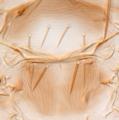Neohydatothrips collaris
Recognition data
Distinguishing features
Female fully winged. Body largely yellow, pronotum with 3 or more pairs of pale grey spots laterally, metanotum and anterior half of mesonotum grey, tergites II–VII with paired grey areas laterally and antecostal ridge weakly shaded; antennae and legs yellow. Antennae 8-segmented, III–IV with short forked sensorium. Head with 3 pairs of ocellar setae, pair III close together within triangle; median postocular setae about as long as distance between posterior ocelli; mouth cone extending between fore coxae. Pronotum with irregular transverse striae on anterior half but with no "blotch", posteroangular setae 70 microns. Metanotum with weak transverse striations at anterior, medially with irregular reticulation. Fore wing with first vein setal row complete. Abdominal tergites II–V median setae with distance between their bases scarcely twice diameter of setal pore; VII–VIII with posteromarginal comb of microtrichia complete but short. Sternites with lateral microtrichial fields weak but setae stout.
Related and similar species
The irregular reticulation medially on the metanotum distinguishes this pale colored species from the others recorded from California. The genus Neohydatothrips is found in many parts of the world and almost 100 species are included. Identification keys are available to 13 species recorded from Central America (Mound & Marullo, 1996), and Stannard (1968) treats 11 species from Illinois, but many of the 35 species described from the USA north of Mexico (Nakahara, 1988) remain poorly defined.
Taxonomic data
Current valid name
Neohydatothrips collaris (Hood)
Original name and synonyms
- Sericothrips collaris Hood, 1936: 91
Family placement
Thripidae, Sericothripinae
Biological data
Life history
Presumably breeding on leaves.
Host plants
Collected several times in California from Hymenoclea salsola (Asteraceae).
Tospoviruses vectored
None
Crop damage
None
Distribution data
Area of origin
Western USA
Distribution
California, Arizona, New Mexico






